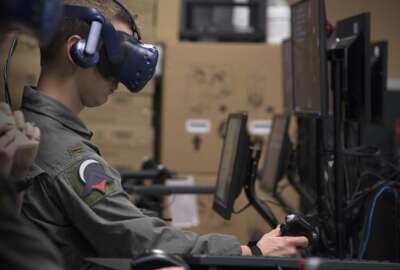Pilot Training Next is now an entrenched way for the Air Force to teach fixed-wing student pilots to fly using virtual reality, biometrics and other cutting-edge technologies — but what about helicopter pilots?
The trainers at the 23rd Flying Training Squadron thought the same thing, and set out to find a way to give rotary-wing students a leg up on their learning.
What transpired was a grassroots effort to create an on-ground learning atmosphere for rotary-wing trainees that the 23rd Flying Training Squadron hopes will be just as successful as its Pilot Training Next predecessor. It’s also saving the Air Force money and flying hours, and so far trainees seem to be benefiting.
“We knew we needed to get away from the antiquated training methods we’d used for years here,” Lt. Col. Jake Brittingham, 23rd Flying Training Squadron commander, told Federal News Network. “We knew there was room to grow and improve and get better use of our resources and start applying some of the technologies we were seeing.”
What the squadron built was a helicopter simulation students can jump into on day one of their training and get familiar with the feel and control of a helicopter before they ever take flight. The first class graduated on Oct. 11.
Getting there took some work, however.
“When we came up with the idea at AFWERX Las Vegas (a collaboration space for industry and government to build innovative technologies) we wanted to get on it right away because we did see the gains that were happening from Pilot Training Next,” Brittingham said. Students of Pilot Training Next, based in Texas, are farther ahead of the learning curve in formal training because of their simulation experience. The program also takes biometric data and uses that to inform future lessons.
Replicating Pilot Training Next wasn’t a matter of just bringing in simulators. Helicopters have different aerodynamics. As a result, simulations were not as advanced and the artificial intelligence used was primitive.
“We had some ideas for how we were going to use this technology, but really we were conducting an experiment to see what works,” said Capt. Jarrod Huffman, part of the Rotary-wing Next team in charge of lessons learned. “There has not been a time where someone has taken a group of students who have not flown in helicopters, put them in a VR environment to learn to fly a helicopter, and then go into an actual aircraft and learn to fly a helicopter in that order.”
Huffman said the Air Force was concerned about the lower quality VR technology for helicopters, and whether it would be useful for students.
The Air Force used commercial-off-the-shelf technology for a civilian helicopter, which did not have the ability to capture biometrics.
Still, students who went through the training were seven to 10 days ahead of schedule once they first got into an actual helicopter, and that saved the Air Force $60,000 per student in fuel and other areas.
“Students had 19 academic days that led up to flying the actual aircraft,” said Capt. Matt Strick, innovation flight commander for the program. “After every single day they had time in virtual reality, which totaled up to about 23.5 hours before they hit the actual aircraft. They were learning all these maneuver parameters, they were learning how to run checklists, they were learning how to talk as a crew and use crew resource management. Normally, when you get a student who goes through the academics on day one they hit the helicopter and now they are trying to learn all this stuff as they’re in a real helicopter.”
Now that the first class is finished, the squadron is planning on doing a second iteration. It wants feedback from formal training first to make sure Rotary-wing Next students keep learning.
The squadron is also investing $400,000 into the next iteration of the program. The money will go to developing a simulation that uses the actual helicopter the students train on and possibly into creating some tools that will be able to capture biometrics.
Copyright
© 2024 Federal News Network. All rights reserved. This website is not intended for users located within the European Economic Area.
